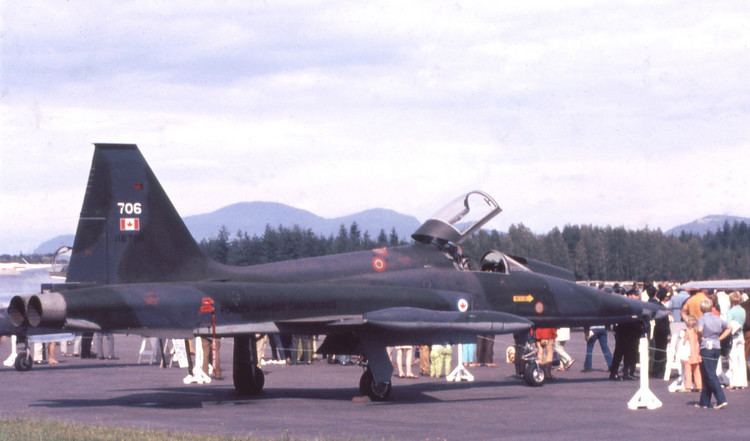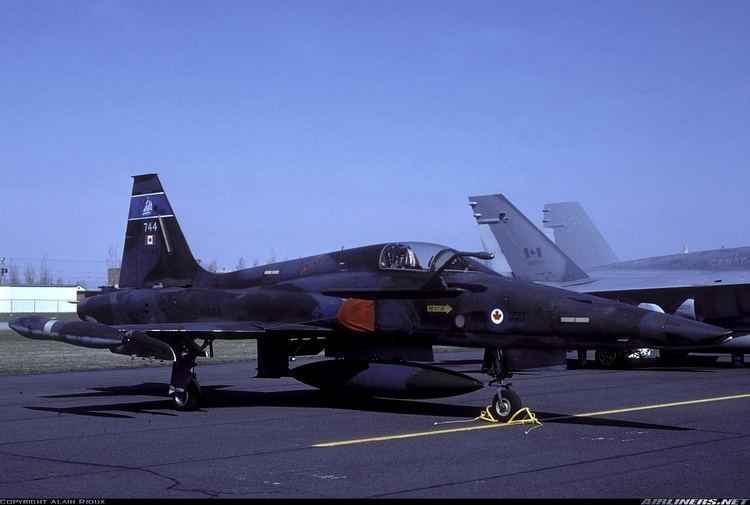Top speed 1,575 km/h Wingspan 7.87 m Cruise speed 834 km/h | Range 1,400 km Length 14 m Weight 3,938 kg | |
 | ||
The Canadair CF-5 (officially designated the CF-116 Freedom Fighter) is the Canadair licensed-built version of the American Northrop F-5 Freedom Fighter aircraft primarily for the Canadian Forces (as the CF-5) and the Royal Netherlands Air Force (as the NF-5). The CF-5 was upgraded periodically throughout its service career in Canada. The Canadian Forces retired the type in 1995, although CF-5s continue to be used by other countries.
Contents
- Design and development
- Canada
- Netherlands
- Variants
- Operators
- Aircraft on display
- Specifications CF 116
- References

The CF-5 was ordered by the Royal Canadian Air Force, which became part of the Canadian Forces on 1 February 1968. The new unified force took delivery of the first CF-5s (it was almost universally referred to as the CF-5 except in official documentation) at the end of 1968. Production by Canadair for the Canadian Forces was 89 single-seat aircraft, 46 dual-seat aircraft and 75 single-seat with 30 dual-seat aircraft for the Royal Netherlands Air Force, a total production of 240. Some surplus Canadian aircraft were sold to Venezuela.

Design and development

Originally designed by Northrop as a low-cost, disposable, low-maintenance fighter jet, the F-5 was intended for use by air forces that had limited resources and technical expertise to maintain a sophisticated aircraft. For Canada, which had an extensive aerospace industry, selection of the F-5 was seen as a step backwards. Selected originally to provide a tactical support role based in Canada, CF-5 squadrons were also committed to NATO's northern flank to act as a rapid-deployment force. However, the role for the CF-5 throughout its service with the RCAF was changed frequently and eventually, the diminutive fighter would serve as a light attack strike fighter, reconnaissance platform and trainer.
The Canadian version had several modifications to make it more suitable for operating in Canadian Forces theaters of operations. In order to address complaints about long takeoff runs, the Canadair version featured a two-position nose landing gear; compressed it operated like the original, but extended (before takeoff) it raised the nose and thereby increased the angle of attack and increased lift. The system reduced takeoff distance by almost 20%. A midair refueling probe was installed, Orenda built General Electric J85-15 engines with 4,300 lbf (19 kN) thrust were used, and a more sophisticated navigation system was added. The nose of the CF-5 was also interchangeable with a specially designed reconnaissance set with four cameras in it. Over the course of its life, it received many upgrades to its avionics and capabilities.
An order for 105 aircraft for the Royal Netherlands Air Force was signed in early 1967, 75 single-seaters to replace the Republic F-84 and 30 twin-seaters to replace the Lockheed T-33. Some single-seaters would be used in the photo-reconnaissance role to replace the Lockheed F-104G Starfighters. Intended production in Europe for both the Dutch and Belgian Air Forces was originally planned, but Belgium did not place an order and the Netherlands government came to a production sharing agreement with Canada. As part of the production sharing agreement between the Canadian and Dutch governments the centre fuselages for all but the first 31 aircraft were built by Fokker in the Netherlands.
The first CF-5 was formally rolled out in a ceremony at the Cartierville factory on 6 February 1968. The first NF-5 was rolled out on 5 March 1969.
Canada
Initially 433 Squadron and 434 Squadron were the only two squadrons to operate the CF-5. It was intended that three squadrons would fly the aircraft, but due to budgetary restrictions, the excess aircraft were put into storage in CFB North Bay and CFB Trenton, some later being sold to other countries. 434 squadron was assigned to do lead-in tactical fighter training for the CF-104, but was transitioned to the role of a rapid reaction squadron, being ready to deploy to Europe at short notice in the event of hostilities. The squadron moved to CFB Bagotville with 433 squadron, for a short time, and then on to CFB Chatham.
The training role was adopted by 419 Squadron in CFB Cold Lake; it would continue to provide jet training, dissimilar air combat training (wearing quasi-Soviet "aggressor" paint schemes similar to USAF, USN and USMC F-5Es), and serve as a lead-in fighter trainer for the CF-18 until the aircraft was retired in 1995. All remaining airframes were put into storage at CFD Mountain View.
Netherlands
The Royal Netherlands Air Force took delivery of its first aircraft (an NF-5B two-seater) in October 1969, with the first squadron to be formed being 313 Squadron at Twente. The initial role of 313 Squadron was a conversion unit to train pilots on the new type. The NF-5 would serve with four operation squadrons, 313 and 315 Squadron at Twenthe, 316 Squadron at Gilze-Rijen and 314 Squadron at Eindhoven. The last NF-5 was delivered in March 1972.
From 1986 the squadrons began to convert to the licence-built General Dynamics F-16 and the last NF-5 was stood down in March 1991.
Most surplus aircraft were sold to Turkey and Venezuela or retained for spares support, a number of aircraft were given free to Greece.
Variants
Operators
Aircraft on display
Specifications (CF-116)
General characteristics
Performance
Armament
Or 2× LAU-10 rocket pods with 4× Zuni 127 mm rockets each
Or 2× Matra rocket pods with 18× SNEB 68 mm rockets each
